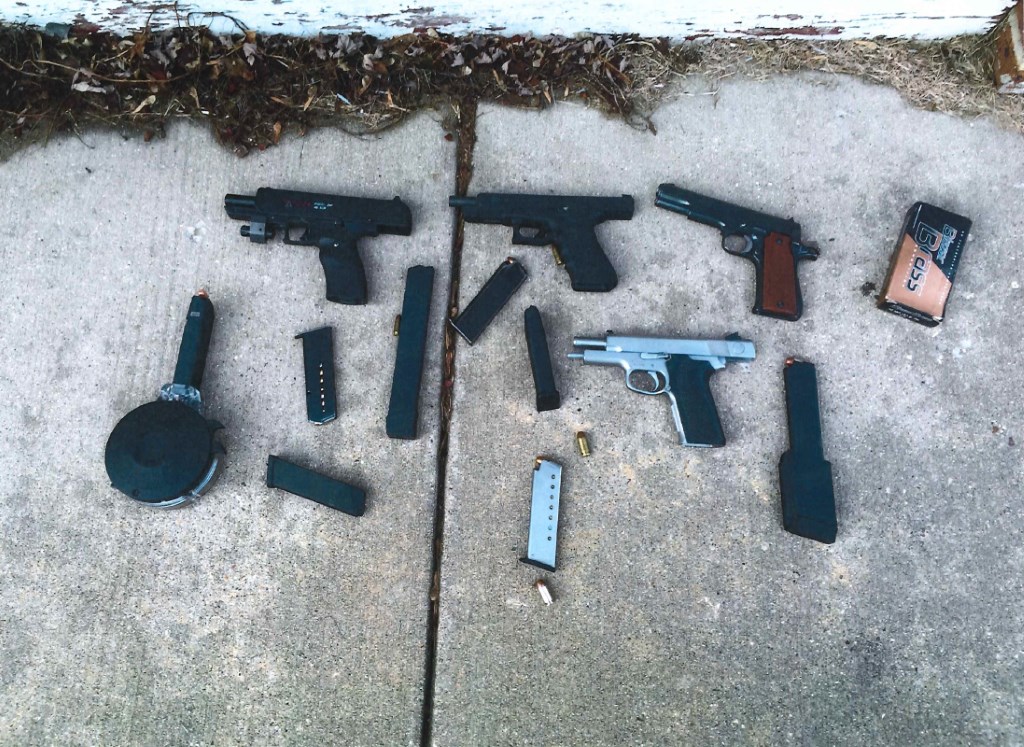MPD Struggles Identifying Source of Crime Guns
Police Department does not maintain a data set on origin of thousands of confiscated firearms.

The Milwaukee Police Department confiscated more than 8,000 guns from Jan. 1, 2020, to July 8, 2022. File photo courtesy of the Milwaukee Police Department.
Though there have been Milwaukee Common Council efforts to address the issue of stolen firearms seized or used in gun violence, there is no aggregate city data that records whether the thousands of guns confiscated annually by Milwaukee police were stolen or legally purchased and possessed.
At the local level here and elsewhere, it is simply not how the data is compiled, though information on where these guns came from may be contained in individual police reports and individually from other sources as well.
Nonetheless, police and elected officials in Milwaukee often point to stolen guns as a factor in the rise of violence in the city in recent years.
In late May, District 4 Ald. Robert Bauman discussed an increase in guns stolen from cars while addressing a downtown shooting. District 15 Ald. Russell W. Stamper, II sought to pass a new ordinance in the Common Council that would have required gun owners to store their guns properly and/or report their guns being stolen within 24 hours of discovery or risk fines of up to $5,000.
But if you ask law enforcement officials or anyone else in the city for data that shows whether the thousands of guns confiscated by police since 2020 were stolen, otherwise acquired by illegal means or legally purchased and possessed, they couldn’t tell you for certain.
That’s because the Milwaukee Police Department has not tracked data on the origin of the more than 8,000 guns confiscated from Jan. 1, 2020, to July 8, 2022, NNS learned from an open records request seeking data related to firearm seizures in Milwaukee.
That means the city lacks an overall picture of where guns used in shootings and other crimes originate from, which could possibly solve other crimes and identify trends to help create new approaches to prevent crime. Some police departments in other states trace every gun they collect, though many do not.
“You’d think strategically this would be one of the many things they would want to figure out,” said David Hemenway, director of the Harvard Injury Control Research Center, regarding the collection of data on gun traces. “This information can help you try to reduce this flow of guns into the wrong hands, rather than waiting until people who shouldn’t have guns use them wrongly.”
A response to a request for data on the origin of guns confiscated by Milwaukee police during the time period from Jan. 1, 2020, to July 2022, from Police Chief Jeffrey Norman and Police Lt. Jay Karas prompted this statement:
“MPD cannot provide the following as it would require a manual review of all reports to obtain this data. Your request is unreasonably burdensome because it encompasses a large number of records (8,076 recovered firearms).”
Paul Lough, an inspector for MPD, said, although this data is collected in various types of reports, including those submitted to the Bureau of Alcohol, Tobacco and Firearms, or ATF, it is not tracked by his department collectively.
Nationally, guns are submitted by many law enforcement agencies to the ATF for tracing and other purposes. Milwaukee police do track data on guns reported stolen in the city. Stamper said during a Common Council meeting earlier this summer that the MPD reported that 863 guns were stolen from vehicles and more than 375 from homes in 2021.
But these numbers reflect guns that were reported stolen and not the guns confiscated by police. Moreover, the numbers don’t tell whether these guns were then used to commit crimes.
In 2020, the last year firearms trace data for Wisconsin and other states is publicly available, 3,144 guns recovered in Milwaukee were traced by the ATF. This differs slightly from the total of 3,097 reported recovered during that time period by MPD through an open records request by NNS.
In addition to the number of guns traced, data from the ATF also tracks the age of the possessor; the length of time from when the gun was purchased to the time it was used in a crime; firearm and caliber types; crime categories; and the top-source states for the firearms. Not included on the ATF website or held by MPD is data that identifies whether the guns were stolen or possessed by the legal buyer when they were confiscated and then traced.
When a firearm is recovered by MPD, he said, it is checked for fingerprints and swabbed for DNA to see if someone who is prohibited from maintaining guns had possessed it. The gun also is fired and the casing entered into the National Integrated Ballistic Information Network, or NIBIN, system to see if it has been used in any incidents in which shots were fired, Lough added.
But other useful data is available. Data available from the Milwaukee Police Department showed that half of the 8,076 firearms that were recovered in the city from Jan. 1, 2020, and July 2022, came from five North and Northwest side ZIP code areas.
These ZIP codes – 53206, 53209, 53218, 53216 and 53210 – were the top five in the number of guns seized and represent 47% of all such confiscations in that period.
The majority of all the guns in the city confiscated were during police incidents (63%); 18% from search warrants; 9% from traffic stops; and 3% from subject stops, according to data obtained from the Milwaukee Police Department through an open records request.
Four other ZIP codes – South Side areas 53204 and 53215, 53208, which includes the Near West Side and parts of the North Side, and 53212, which stretches across parts of the East and North sides – each had more than 500 guns seized during this period.
Lack of data on guns a national problem
Although firearm violence and the gun culture in general is part of America’s legacy, shootings and murders peaked for the most part in the ’80s and ’90s but began to decline in the first two decades of the 2000s. Once the pandemic hit, the number of shootings and homicides in many American cities, including Milwaukee, began to rise.
Milwaukee is in the midst of its third year of record high murders.
Although gun violence has been a persistent problem for many years, federally funded data on guns that can be used to inform policy is insufficient, Hemenway said.
Although this policy, backed strongly by the National Rifle Association, among others, has been amended to allow research on gun violence not specific to gun control, the Dickey Amendment has had a chilling effect, some say.
Hemenway said the policy has made it virtually impossible for researchers to get their hands on gun tracing data.
“Now they provide it aggregately,” he said. “What you really need is good national data to sort of understand the flow of guns and try to reduce this problematic flow. I think it’s hard to do, even hard to do for the police.”
In one example of that challenge, NNS requested data in late May on the origins of guns used in Milwaukee shootings from the Medical College of Wisconsin’s Comprehensive Injury Center, or CIC, which addresses injury prevention and control in the region and operates a Division of Violence Prevention. Requested specifically was data whether the guns were legally owned or purchased or stolen.
An email response from the CIC stated, “Unfortunately no one has this data. Someone did recommend reaching out to MPD.”
Reggie Moore, director of the Division of Violence Prevention and Engagement at CIC, was unavailable for an interview.
Local gun control policy efforts
Stamper said during a meeting of the Public Safety and Health Committee in July that his proposed ordinance requiring firearm owners to report stolen guns or risk fines was created after a rash of shootings in the city, including the mass shooting downtown during the Milwaukee Bucks playoff run.
“Us as Common Council members for years have been trying to do what we can to prevent gun violence,” he said.
A review by the Ordinance Enforcement Division of the City Attorney’s Office found that Wisconsin state law requires that gun regulations be enacted at the state level before a city enacts a municipal ordinance.
“Overall, we support the intentions of the proposed ordinance. Research shows that reporting lost and stolen firearms helps reduce violence. … There is no state statute on point for either subsection of this proposed ordinance. Enacting this ordinance would be unlawful,” read part of a letter from City Attorney Tearman Spencer to Stamper explaining his office’s decision.
Stamper declined numerous NNS requests to discuss the ordinance for this story.
Studies on whether stolen guns are responsible for most crimes have been mixed. One 2016 study on state and federal inmates from the Bureau of Justice Statistics found that only 6% of the more than 280,000 inmates included in the analysis had stolen the gun they possessed during their offense. A larger majority, 43%, had obtained it off the street or from an underground market. A quarter obtained it from a family member or friend as a gift.
Nevertheless, stolen guns, like all other guns, are used in crimes and trafficked by criminals. Better understanding the supply side of guns used in crime and their flow at a local level is crucial to reducing crime, Hemenway said.
“We know so many guns are stolen, but we don’t know exactly how the flow of guns goes from theft to crime,” he said. “What policies are most cost-effective and what policies work we don’t know, because we don’t know some of the basics of this problem.”
Where did that gun used in a crime come from? Milwaukee police can’t easily tell you was originally published by the Milwaukee Neighborhood News Service.





















